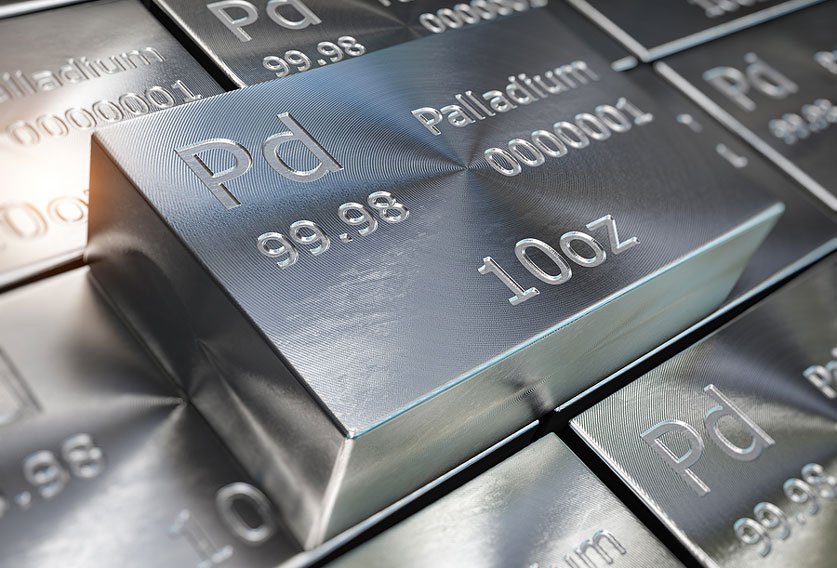 The future of palladium is a big question mark in the eyes of investors as industrial demand for this precious metal dips sharply. The automotive sector’s rapid transition from fossil fuel to electric vehicles (EVs) has been slowing palladium purchases, and the situation will likely continue. Smart money is looking to see what this trend might do to influence the projected value of palladium and its merits as an investment moving forward.
The future of palladium is a big question mark in the eyes of investors as industrial demand for this precious metal dips sharply. The automotive sector’s rapid transition from fossil fuel to electric vehicles (EVs) has been slowing palladium purchases, and the situation will likely continue. Smart money is looking to see what this trend might do to influence the projected value of palladium and its merits as an investment moving forward.
Palladium’s Dependence on the Automotive Industry
It’s difficult to overstate how much palladium depends on the automotive sector. In 2022, it accounted for 83% of global palladium demand. Furthermore, the majority of the metal’s vehicular demand stems from a single product: catalytic converters. The rest of the demand is spread out amongst general industrial uses and jewelry. Following the metal’s discovery in the early 19th century, the booming automotive industry was the initial tailwind to palladium’s value. As a result, the future of palladium is inextricably linked to the future of the auto sector which is undergoing a seismic shift.
Electric Vehicles Threaten the Future of Palladium
In an attempt to thwart climate change, governments and international organizations have been on a years-long crusade to decrease the use of fossil fuels in favor of electricity. The automotive industry has been placed at the epicenter of this transition due to its high dependence on gas and diesel. Initially, this eco-conscious thrust greatly benefitted palladium demand given the metal’s unique ability to convert harmful emissions into less dangerous particles.
For a while, catalytic converters were the preferred method for combatting harmful pollutants caused by the use of fossil fuels in vehicles. However, with zero emissions, electric-powered vehicles don’t require exhausts let alone systems with specialized filtration. The end goal of climate change activists has always been to supplant gas-powered cars with EVs. Catalytic converters are simply seen as a stepping stone on the path to electrification.
These efforts have proven tremendously effective with EV demand rising sharply over the past few years. In just a six-year span from 2017 to 2023, EV sales skyrocketed from 1 to 14 million. The whole EV market is expected to double within the next five years. Some experts even anticipate EV sales to outstrip that of fossil fuel-powered vehicles by 2040.
The uncertain future of palladium demand is reflected in its price performance. In 2022, palladium prices notched a record high of $3,440.76/oz on the back of the Russian invasion of Ukraine. Since then, prices have dropped dramatically, representing a more than 70% drop within two years.
What about the future of palladium prices?
As is the case with any asset, it’s impossible to predict the future value of palladium perfectly. This is especially true given the volatility of the palladium market. However, as palladium’s primary source of demand dwindles swiftly with the momentum of government intervention, the forecast doesn’t look promising. Unless another compelling use case arises for palladium, this shiny metal’s value might see continued devaluation. In fact, many experts have drastically lowered their projections for palladium prices in the wake of the automotive industry’s widespread transition from fossil fuels to electricity.
👉 Suggested Reading: Why Palladium Prices Can Be So Volatile
The Advantages of Gold & Silver
If you’re looking for wealth preservation offered by precious metals without the uncertainty of the palladium market, you might want to consider gold and silver. These popular safe-haven assets tend to see greater price stability when compared to palladium for a few key reasons:
Long Histories
Gold and silver have extensive track records as valuable assets. These metals have been used as investment vehicles for centuries. In contrast, palladium was only discovered in 1804. This relative lack of history contributes to a shakier market as investors have less confidence in the underlying asset when compared to the more mature gold or silver markets.
Diversified Demand
Unlike palladium, which relies largely on a single industry, gold and silver see widespread and varied demand. Although there are many factors that influence precious metals prices, diversified use contributes greatly to improved stability and predictability. Even if a single use for gold or silver were to disappear, overall demand would remain relatively unchanged.
Large Markets
Another reason to consider gold and silver is market size. With greater trading volume and more participants, these markets see steadier price action and higher liquidity than palladium markets. Generally, gold and silver trading yields more consistent price returns when contrasted with the volatility and unpredictability of palladium.
👉 Related reading: Gold vs Palladium: Investing Considerations
If you’re interested in learning more about diversifying with gold and silver, claim a copy of our FREE Precious Metals Investment Guide. It covers the basics of investing in metals for optimized protection against economic instability.


